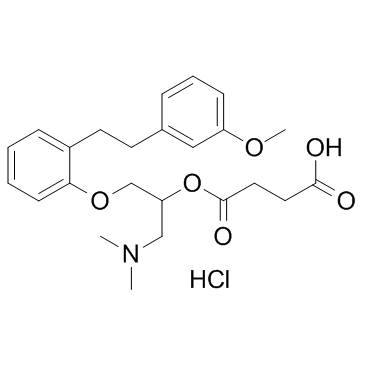
Sarpogrelate hydrochloride
CAS No. 135159-51-2
Sarpogrelate hydrochloride( MCI 9042 | MCI9042 | MCI-9042 )
Catalog No. M11420 CAS No. 135159-51-2
A potent, specific 5HT2 receptor antagonist with Ki of 8.39 nM for 5-HT2A; also shows binding affinity for 5-HT2B.
Purity : >98% (HPLC)
 COA
COA
 Datasheet
Datasheet
 HNMR
HNMR
 HPLC
HPLC
 MSDS
MSDS
 Handing Instructions
Handing Instructions
| Size | Price / USD | Stock | Quantity |
| 5MG | 37 | In Stock |


|
| 10MG | 59 | In Stock |


|
| 25MG | 110 | In Stock |


|
| 50MG | 176 | In Stock |


|
| 100MG | 259 | In Stock |


|
| 500MG | 619 | In Stock |


|
| 1G | Get Quote | In Stock |


|
Biological Information
-
Product NameSarpogrelate hydrochloride
-
NoteResearch use only, not for human use.
-
Brief DescriptionA potent, specific 5HT2 receptor antagonist with Ki of 8.39 nM for 5-HT2A; also shows binding affinity for 5-HT2B.
-
DescriptionA potent, specific 5HT2 receptor antagonist with Ki of 8.39 nM for 5-HT2A; also shows binding affinity for 5-HT2B; displays selectivity over 5-HT1-like, 5-HT3, beta, H1, H2 and M3; blocks serotonin-induced platelet aggregation.Heart Failure Approved(In Vitro):Sarpogrelate is selective for 5-HT2 (pKi=7.54) over 5-HT1 (pKi=4.58), α1-, α2-, and β-adrenergic (pKi=3.17-6.19), and muscarinic receptors (pKi=4.39).Sarpogrelate (10 μM) significantly reduces the number of platelet-rich plasma (PRP)-induced THP-1 cell that adheres to human umbilical vein endothelial cells (HUVECs).Sarpogrelate (10 μM) significantly reduces the expression of PRP-induced E-selectin in HUVECs.(In Vivo):Sarpogrelate (5 mg/kg; i.p. daily for 4 weeks) inhibits HFFD-induced obesity and decreases leukocyte-endothelial interactions in mice.
-
In VitroSarpogrelate is selective for 5-HT2 (pKi=7.54) over 5-HT1 (pKi=4.58), α1-, α2-, and β-adrenergic (pKi=3.17-6.19), and muscarinic receptors (pKi=4.39).Sarpogrelate (10 μM) significantly reduces the number of platelet-rich plasma (PRP)-induced THP-1 cell that adheres to human umbilical vein endothelial cells (HUVECs).Sarpogrelate (10 μM) significantly reduces the expression of PRP-induced E-selectin in HUVECs.
-
In VivoSarpogrelate (5 mg/kg; i.p. daily for 4 weeks) inhibits HFFD-induced obesity and decreases leukocyte-endothelial interactions in mice. Animal Model:Male C57BL/6 mice (7 weeks old) are fed normal chow (NC) or a high-fat diet with 30% fructose in the drinking water (HFFD)Dosage:5 mg/kg Administration:I.p. daily for 4 weeks Result:Prevented the HFFD-induced increases of the body weight, visceral fat weight, and serum monocyte chemoattractant protein-1 levels.Decreased leukocyte-endothelial interactions and serum monocyte chemoattractant protein-1 (MCP-1) level.
-
SynonymsMCI 9042 | MCI9042 | MCI-9042
-
PathwayEndocrinology/Hormones
-
Target5-HT Receptor
-
Recptor5-HT Receptor
-
Research AreaCardiovascular Disease
-
Indication——
Chemical Information
-
CAS Number135159-51-2
-
Formula Weight465.967
-
Molecular FormulaC24H32ClNO6
-
Purity>98% (HPLC)
-
SolubilityDMSO: ≥ 62 mg/mL
-
SMILESCN(C)CC(COC1=CC=CC=C1CCC2=CC(=CC=C2)OC)OC(=O)CCC(=O)O.Cl
-
Chemical NameButanedioic acid, 1-[2-(dimethylamino)-1-[[2-[2-(3-methoxyphenyl)ethyl]phenoxy]methyl]ethyl] ester, hydrochloride (1:1)
Shipping & Storage Information
-
Storage(-20℃)
-
ShippingWith Ice Pack
-
Stability≥ 2 years
Reference
1. Kikumoto R, et al. J Med Chem. 1990 Jun;33(6):1818-23.
2. Pertz H, et al. J Pharm Pharmacol. 1995 Apr;47(4):310-6.
3. Nishio H, et al. Arch Int Pharmacodyn Ther. 1996 Mar-Apr;331(2):189-202.
molnova catalog



related products
-
4F 4PP oxalate
4F 4PP oxalate is a 5-HT2A antagonist.
-
R-Lorcaserin hydroch...
R-Lorcaserin hydrochloride hemihydrate is a selective 5HT2C serotonin receptor agonist.
-
Trazodone
Trazodone, a 5-HT 2A/2C receptor antagonist, is used as an antidepressant for treating major anxiety disorders and depressive disorder.



 Cart
Cart
 sales@molnova.com
sales@molnova.com


